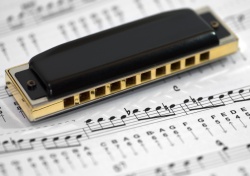Crossing The Bridge
 In cross-harp (2nd position) it is easy to limit your playing to blues patterns between holes 1 and 6. Accepted, some songs require this, focusing on the wealth of ‘low end’ bends, moods and tones. But what do we do with the ‘top end’ of the harp? It’s banjo country and it’s scary – you just don’t want to go there! This is because the tuning sequence changes in holes 7 to 10 and cross-harp patterns have to change with it. Those favoured low end formulae are rendered useless as everything seems to reverse or shift. Remember how mysterious the low end was when you first picked up the harp? Time, determination, experiment and the sense of adventure all spurred you on to greater things. Breaking into the top end is no different. So it’s back to school…
In cross-harp (2nd position) it is easy to limit your playing to blues patterns between holes 1 and 6. Accepted, some songs require this, focusing on the wealth of ‘low end’ bends, moods and tones. But what do we do with the ‘top end’ of the harp? It’s banjo country and it’s scary – you just don’t want to go there! This is because the tuning sequence changes in holes 7 to 10 and cross-harp patterns have to change with it. Those favoured low end formulae are rendered useless as everything seems to reverse or shift. Remember how mysterious the low end was when you first picked up the harp? Time, determination, experiment and the sense of adventure all spurred you on to greater things. Breaking into the top end is no different. So it’s back to school…
Stick with it – there’s fun and satisfaction to be had. In due course, 3rd position will have you skipping across the divide like a spring lamb, oblivious to worldly perils. For now, the first steps in linking the bottom and top ends are what we call ‘crossing the bridge’ exercises. Try out these helpful 2nd position licks:

 If I catch you bending, I’ll saw your legs right off..
If I catch you bending, I’ll saw your legs right off..